Growing a business in an overwhelmingly competitive digital landscape can be challenging for both new companies and experienced brands. You seem to make all the right moves, but your competition is constantly getting ahead of you.
While your business operation remains limited, your competitors continue to expand to new territories. Competitive analysis can be a powerful tool for analyzing your market, identifying your competitors, and finding the best ways to get ahead of the curve. Let’s discuss what this analysis is and how to conduct it.
What is a Competitive Analysis?
Competitive or competitor analysis is a study that compares a company’s strengths and weaknesses to those of its competitors to help business owners adjust business strategies and grow their operations.
It allows a business to study and identify market aspects that could give it a competitive advantage. Enterprises use competitive analytics to compare competitors’ strategies, monitor market events and trends, and study the most successful business tactics, such as product and service distribution, pricing, and marketing.
Experienced business leaders rely on competitive analyses to monitor their competitors and gather insights into their marketing, sales, and product pricing strategies.
The analysis provides many business benefits, such as:
- Identifying your strengths and weaknesses;
- Discovering your brand image and position in the market;
- Getting insights into your competitors’ business, marketing, and sales strategies;
- Studying competitor product descriptions, customer testimonials, user reviews, demographics, market shares, and top product features.
Conducting this analysis allows you to create a unique value proposition for your products and services and make your brand stand out in your market. You can create an ideal buyer persona and bring your brand closer to broader audiences.
In addition, regular competitive analyses help your company identify new business opportunities, expand into new territories, form partnerships, promote products and services, enhance digital presence, etc.
Why Use a Competitive Analysis?
Competitor market analysis brings you business benefits that you simply can’t ignore. Since it is an essential tool for helping your business stay ahead of competitors, you can use it to forecast market events and anticipate changes that can give you the leverage you need to grow your business.
However, it can also help you identify potential risks and mitigate threats before they escalate and affect your operations. Furthermore, studying your competitors and respective market also allows you to position your company higher in search results across leading search engines. You can use the insights from competitive analyses to create SEO-driven strategies and launch campaigns to make your brand more visible to broader audiences.
Conducting the analysis isn’t only about improving your marketing efforts and beating the competition; it’s also about delivering exceptional customer service and experiences to your customers. The demographic insights you receive from the market analysis can help you better understand your customers, competitors, and respective market.
Analyzing your competitors can help you:
- Improve your decision-making process;
- Cope with the latest market events and industry trends;
- Get ahead of your competitors;
- Create a unique value proposition;
- Adjust your pricing;
- Attract new customers;
- Create meaningful relationships with your target audience;
- Identify your and your competitor’s advantages and disadvantages;
- Bridge market gaps to position your brand higher;
- Create better products and services that offer real value;
- Improve sales;
- Generate more leads.
Companies must constantly innovate their strategies and campaigns to stay relevant and competitive in a digital business landscape. Following the latest trends is the only way to stay ahead of the curve. Business leaders must work round the clock to make their products and services more accessible, usable, and reliable. Modern consumers demand customer-centric brands today. If you can’t deliver, they will look elsewhere.
How to Conduct a Competitive Analysis for Your Business
Here are the steps for conducting this analysis for your business:
Identify your competitors
Start by identifying your biggest competitors. Search for them on Alexa, Amazon, and Google. Look for companies that share your business idea and offer. Find companies that offer similar services or products and have a similar business mission to yours.
Make sure they cater to the same target audience and have long years of marketplace experience. Narrow down your selection to 7-10 main competitors and focus your competitor analysis efforts on them. Use their contact details to complete your competitor profiles by adding information on your competitors’ revenues, market shares, company sizes, primary objectives, business missions, etc. Gather as many company details as possible by overviewing your competitors’ general information and business profiles.
Identify details like value proposition, tagline, slogan, mission statement, the names of managers, team leaders, and executives, SEC (Securities and Exchange Commission) filings, recent business acquisitions, workforce numbers, and the headquarters location.
Pay special attention to companies that offer similar services and products as they are your biggest rivals. But you shouldn’t neglect indirect competition. Indirect competitors are the companies that offer slightly different services and products that match yours in value and features. They could give you insights into potential new business opportunities.
Determine types of competitors
Separate your competitors into matching categories. There are three categories of competitors:
- Direct (primary) competitors – these companies offer similar products and services as yours.
- Indirect (secondary) competitors – these brands target the same customers and market but offer slightly different products and services.
- Tertiary competitors – these businesses offer different categories of products and services but solve the same problems as your company.
Direct competitors are your biggest opponents as they have almost the same offer as yours. Indirect competitors aren’t an immediate threat but could become one soon. Finally, tertiary competitors are not a threat to your business. However, you can learn from their examples and even form future partnerships.
Create a spreadsheet
You should create a spreadsheet to keep the gathered data well-organized and easily accessible. You can easily update or share your spreadsheet with your team. Spreadsheets or tables allow you to categorize your competitors by comparing their strengths and weaknesses.
Your analysis spreadsheet should include criteria like pricing structure and range, product descriptions, special offerings, customer engagement on social media channels, lead generation strategies, welcome offers, special deals and bonuses, loyalty programs, etc.
The criteria you gather for your spreadsheet can help you create the final analysis report on your main competitors.
Identify your competitors’ positioning
Many brands overlook business positioning, but that’s a massive mistake. High brand positioning makes your company more visible online. It’s one of the most effective marketing tactics for attracting more prospects and increasing customer engagement.
Positioning refers to everything related to your business, from your business strategy and company values to marketing, brand image, and messaging. The more you understand your competitors’ positioning, the more you can present your brand as an authoritative force in your market to make it stand out. More importantly, brand positioning can positively impact your brand image and reputation by providing social proof to justify your prices and increase brand awareness.
Several factors determine brand messaging and positioning, such as customer engagement on social media channels, product and website copy analytics, PR and events metrics, etc.
Positioning should help you understand your competitors and their shareholders, partners, employees, customers, and followers by providing the following insights:
- The brand message they send to their consumers;
- Strategies they use to market their products and services on different marketing channels;
- Tactics and content present in their company and product description;
- The data they gather to create their unique value proposition.
These insights should help you set your business apart from your competitors by using their strategies against them.
Determine competitive advantage and offerings
Once you gather enough information on your competitors and understand their strengths and weaknesses, it’s time to focus on their products and services. Top-grade companies use customer-centric marketing strategies to keep their customers engaged and interested.
For example, they offer expedited shipping services (often for free), reasonable prices, 24/7 customer support, and top-quality promotional content to keep consumers loyal to their brands. Therefore, you need unique selling propositions to establish trustworthy and authoritative brand recognition for your business.
Start by comparing your competitors’ services and goods to your own. Then, gather user and customer reviews to ascertain how competitors and customers see your brand. That should help you understand what separates your brand from the competition and form a better offer for your target audience. Finally, compare core features to see what separates your brand from your competition and use that knowledge to add more value to your marketing messages.
Determine what products your competitors offer
The next step in your analysis is determining what products work best for your competition. Products and services are the very core of every business. Analyze your competitors’ complete product or service lines to gather actionable insights on the type and quality of everything in their catalogs. Pay special attention to their pricing, promotions, deals, vouchers, coupons, and discounts.
Determine the following information about your competitors:
- Whether they are high-cost or low-cost providers;
- Whether they focus on one-off purchases or volume sales;
- Market share by the competitor;
- Your competitors’ ideal buyer persona (needs, preferences, characteristics, etc.);
- Brick-and-mortar vs. online pricing strategies;
- The channels they use to distribute their products or services.
Understand how your competitors market their products
Top marketing techniques and high-quality content are the two driving factors of business success in the digital business landscape. Of course, you should have a high-quality offering to disturb the market, but digital marketing drives your success.
Therefore, focus on your competitors’ tactics for marketing their products or services. They probably use marketing techniques such as SEO, Facebook ads, and Instagram promotions for maximum reach. However, that won’t tell you how they market their products. You need to figure out how and when they share marketing content online, how they gather contacts, and what offers they promote.
You can collect the insights for analysis you need by:
- Visiting your competitors’ websites;
- Purchasing their products or services;
- Contacting their customer service;
- Abandoning their shopping carts;
- Following their blogs and social media pages and channels;
- Signing up for their newsletters and email promotions.
Document the insights you gather on how they mitigate problems, handle customer issues, address queries, engage with new contacts, and manage cart abandonment to understand what drives their marketing and sales departments. Moreover, tap into their marketing strategies and study their marketing techniques.
You can learn a lot about their marketing approach by addressing the following:
- Blog content and web page maintenance;
- The use of ebooks and whitepapers;
- Webinars, podcasts, and video content;
- The use of static images and infographics in their content marketing strategies;
- FAQs section;
- Featured articles and guest posting;
- Press releases and media kits;
- Case studies and references;
- Datasheets and buying or user guides;
- Online and offline advertising campaigns.
Once you gather the information on your competitors’ marketing techniques, study their pricing strategies to see what perks work for their customers the most. Hopefully, that should help you learn how they form the price for their products or services.
If they offer superior features to yours, you might consider lowering the prices of your products or services to meet the industry standards. Making them more affordable is an excellent way to attract more customers, but only if you can offer top quality at budget-friendly prices.
Research your competitors’ sales tactics and results
Most online shoppers will abandon their cart if the shipping costs are too high. That is why online businesses offer perks like free shipping to keep their customers loyal to their brands.
No matter what industry your company belongs to, research the best ways to differentiate yourself from the rest, such as offering giveaways on social media, holiday discounts, promotional deals, rewards, loyalty programs, etc. Aside from promotions, you should look into your competitors’ sales tactics to better understand how their sales process works.
Research factors like:
- The steps that comprise their sales process;
- The channels they use for sales;
- The number of locations they have;
- Their scalability and expansion potential;
- Their partner reselling programs;
- Their customers’ complaints and objections;
- Negative customer reviews and testimonials;
- Annual revenues and total sales volume;
- Regular discounts and other promotions.
All these factors can give you actionable insights that can help you understand your competitors’ sales processes and what you must do to outmatch them. Survey your target audience and ask them how they feel about your brand. Figure out what drives your customers to reach out to your competitors. Consider implementing a new system where you can gather customer feedback on services, products, and providers they prefer.
Surveys and customer feedback are abundant sources of actionable insights that can help you understand what your competitors do better than you. In addition, you’ll get an opportunity to build a long-lasting relationship with your audience.
Take note of your competition’s content strategy
The content marketing strategy should be the next item on your list. Look at the number of blog posts your competitors have and assess how frequently they use their content assets. Study their social media and website activity to learn their publishing patterns. Search for ebooks and whitepapers and the topics your competitors address regularly. The content assets of your competitors could help you gauge their lead-generating strategies. Assess the quality of their marketing messages and what value they offer to the target audience.
Save your time, effort, and resources by reviewing the most effective content samples that deal with real-life problems and provide actionable solutions for the target customers. Pay attention to details like content accuracy, topic variety, tone, readability, grammar, etc. These details can tell how your competitors manage marketing content and campaigns, the preferred fonts, styles, and formats, and whether their marketing messages are free and available. Thoroughly examine the types of content your competitors use for marketing, such as video, images, photos, calls to action, text quotes, etc.
Finally, analyze the competitors’ customer engagement to see what makes their prospects tick. Check the number of likes, shares, and comments on social media. Create a report on the topics that best resonate with the consumers and the tone they use when interacting with your rivals. Once you understand the content and customer engagement, assess how your competitors promote their marketing content.
Here are some details to write down:
- Keywords they use and their density;
- Images and alt text;
- Internal links.
Your competitors might be using keywords that you’ve missed. Review your marketing content and add the missing keywords to improve your SEO. Enrich your content with internal links and optimize it for different social media platforms to increase your organic reach.
Learn what technology your competitors use
The easiest way to tap into the technology of your competitors is to use a tool to reveal the apps and software their sites run on, the plugins and systems they use to manage customer relations and queries, etc.
The chances are they might be using better CRM software or more advanced analytics systems, which is why they achieve better results.
The social media channels you choose to deliver marketing messages determine the level of your advertising success. Each is unique and can drive better engagement and social media presence. Therefore, study how your competitors engage with their audience and what tricks they use when sharing posts online. Search for the links, social sharing buttons, and calls to action.
In addition, determine what channels they use by checking their accounts on platforms, such as; LinkedIn, YouTube, Pinterest, Instagram, Snapchat, Twitter, Instagram, etc. Monitor their channels to uncover content virality, engagement, posting consistency and frequency, and the number of followers per social media platform.
Perform a SWOT analysis
A SWOT analysis investigates your competitors’ strengths, weaknesses, opportunities, and threats. It allows you to learn more about what your competitors are good at and the areas where they need improvement. You can also identify what their customers complain about to gain the upper hand. A SWOT analysis is critical to your competition monitoring strategy as it allows you to identify competitors’ reputations, product offerings, ongoing partnerships, intellectual property, workforce numbers, market shares, and equity assets. You can use these analytics and compare them to your performance to identify business aspects that need improvement.
Here are the steps for conducting a thorough SWOT analysis of your competitors:
- Find out what marketing strategies your competitors are using for different communication channels (social media networks, content marketing, digital marketing, emails, products, etc.);
- Identify the areas where your competitors outperform your brand and vice versa;
- Gather a list of your competitors’ weaknesses;
- Highlight the areas where your competitors most threaten your brand;
- Tap into the business and market opportunities of your competitors.
Free Templates
Word format
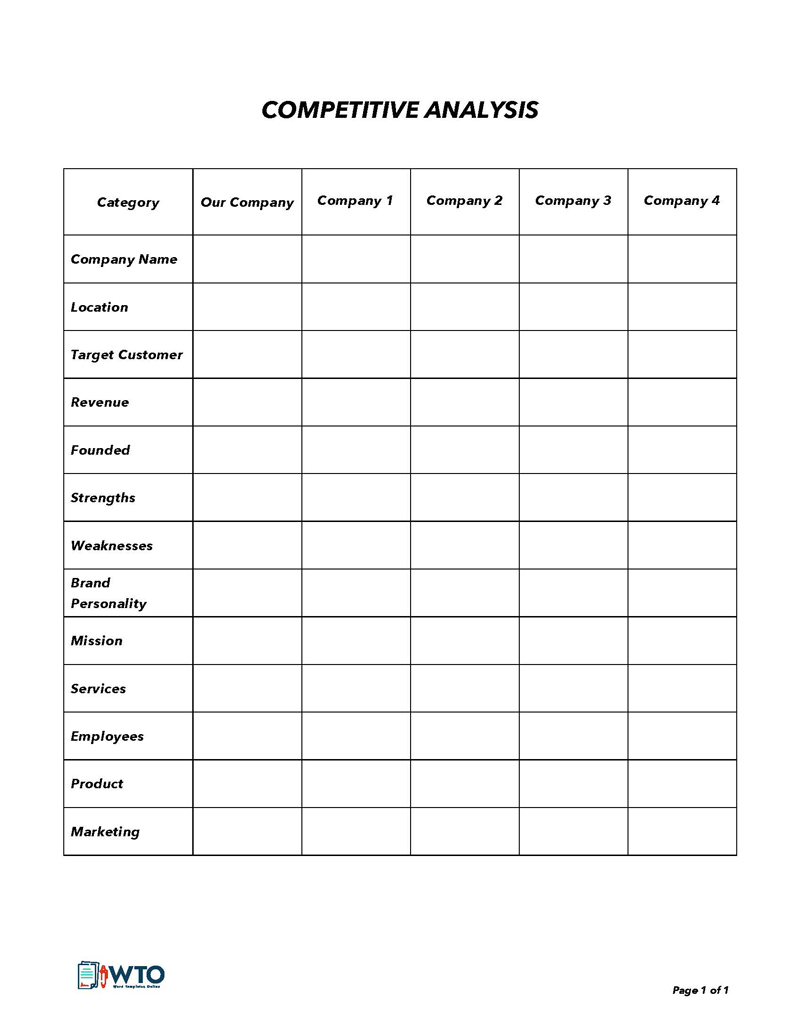
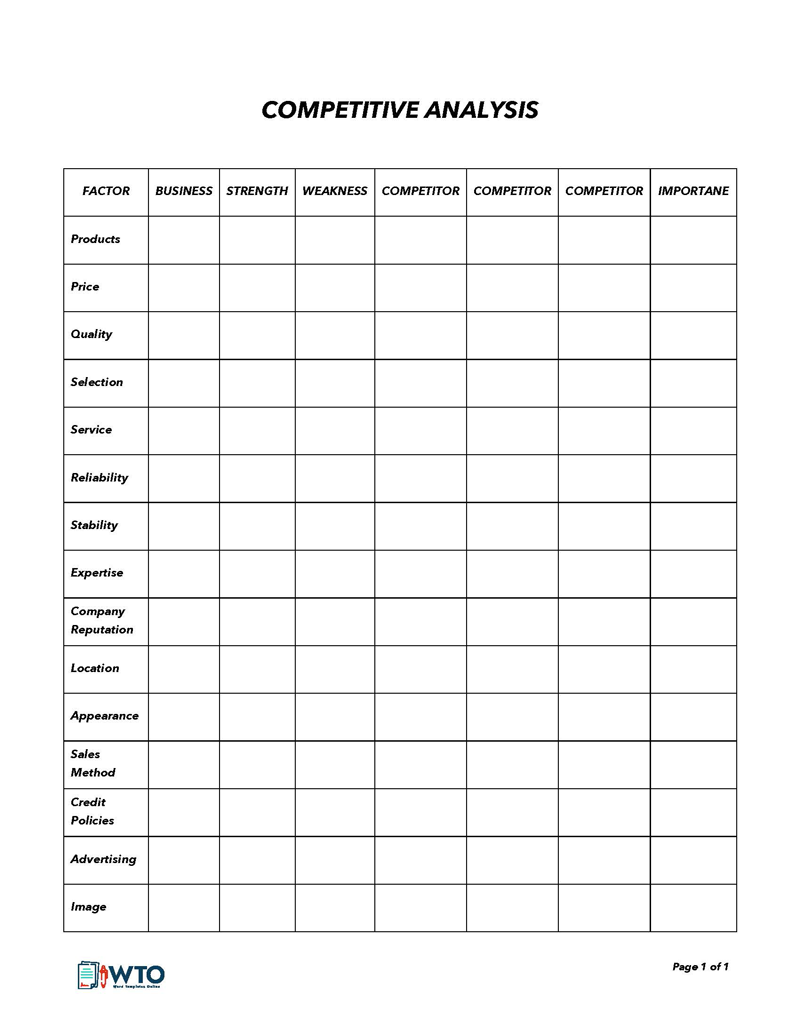
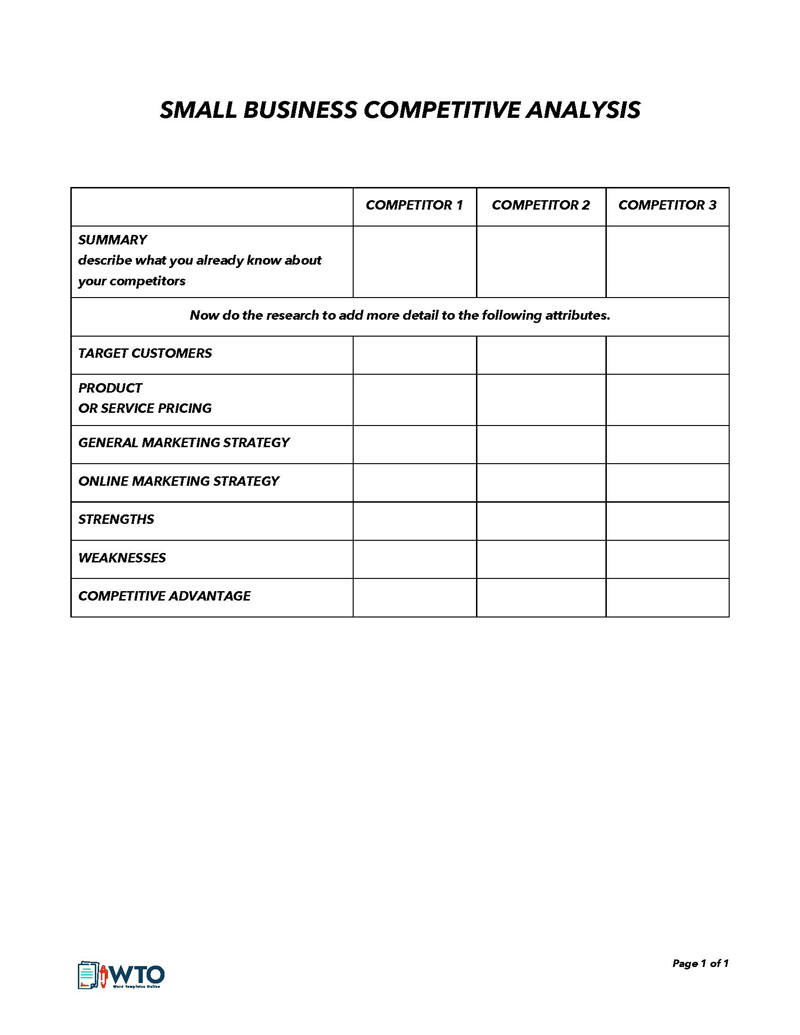
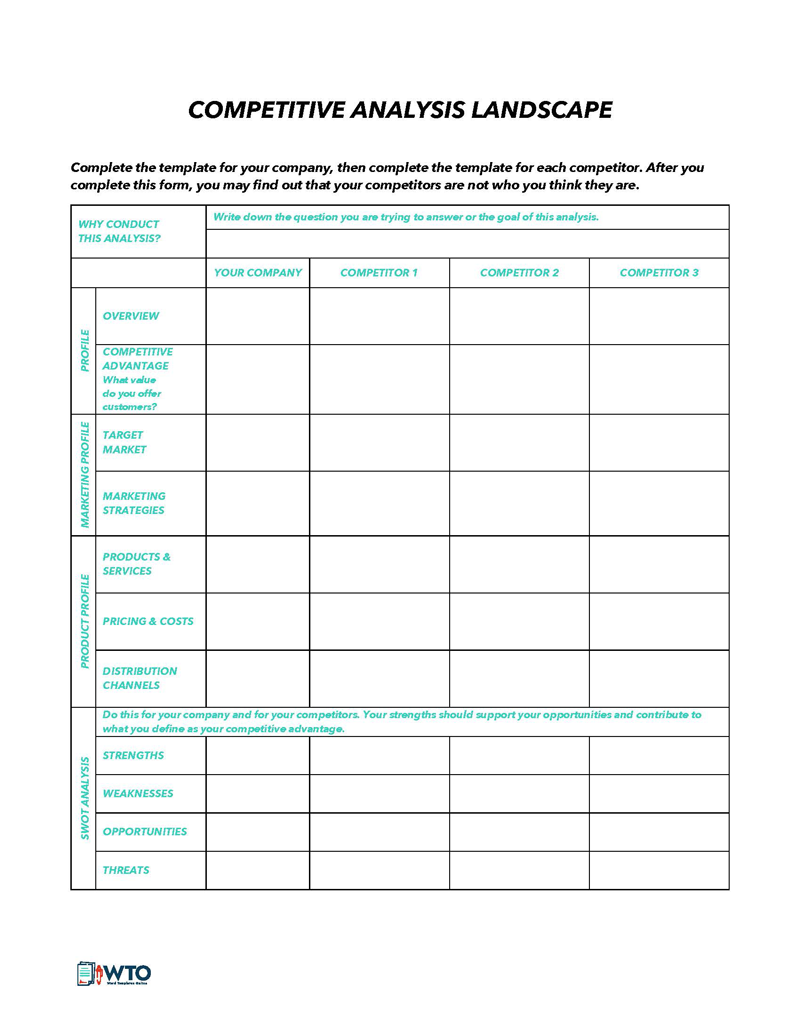
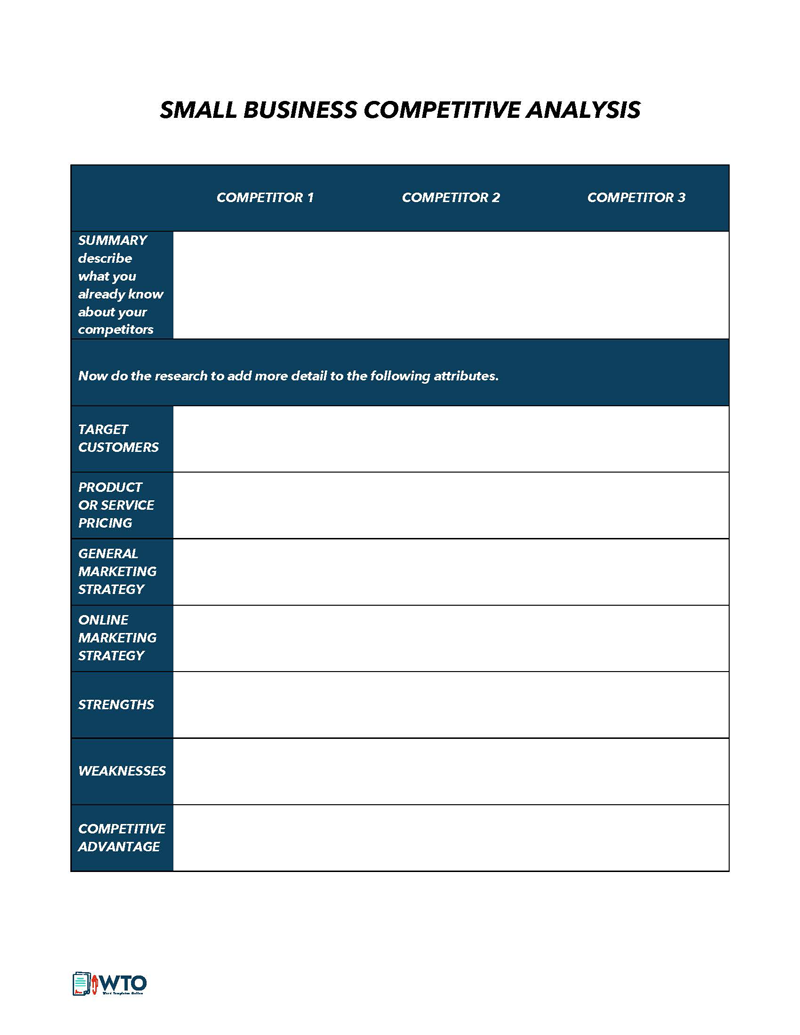
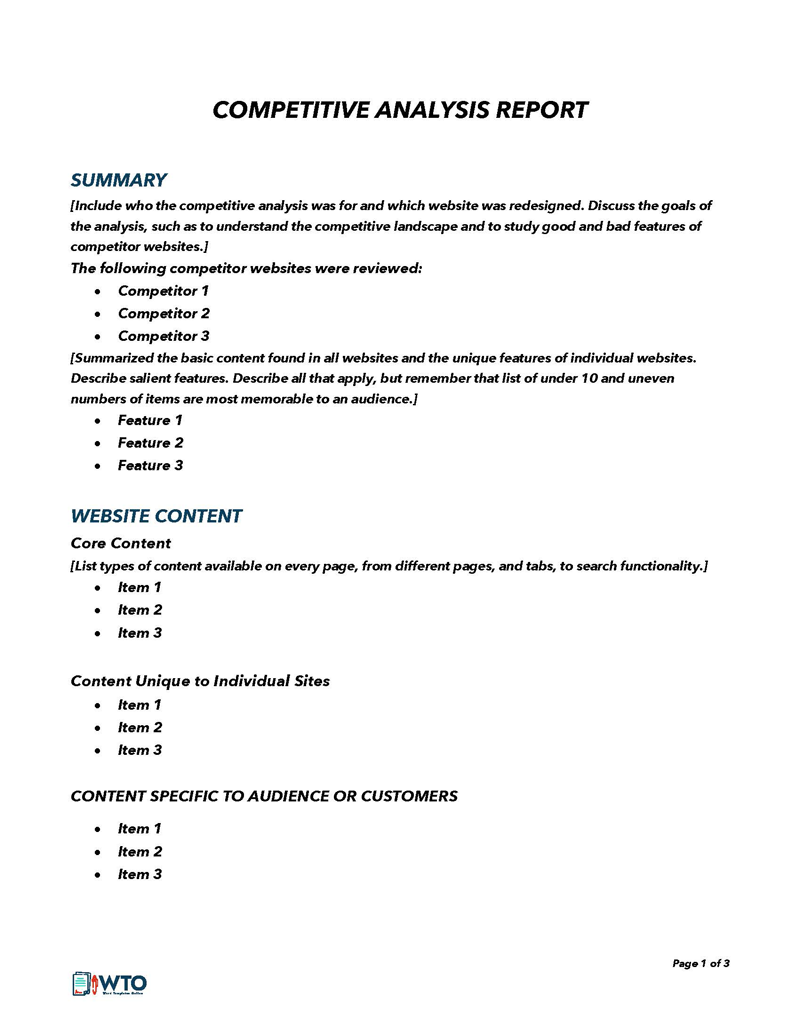
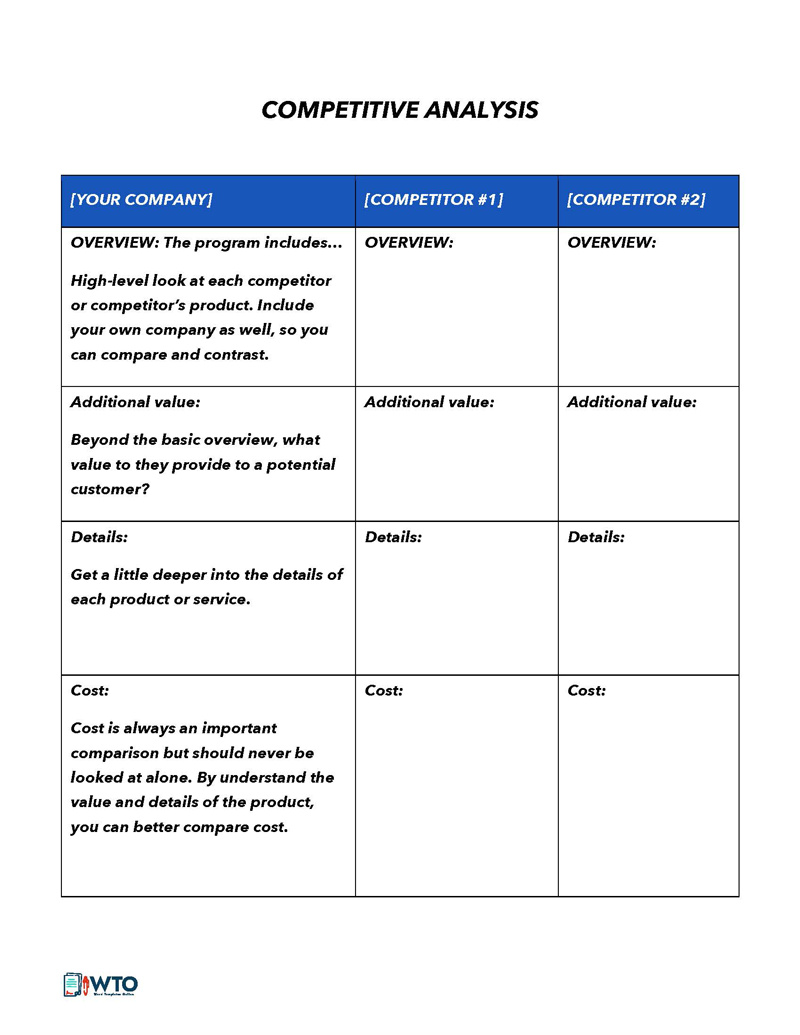
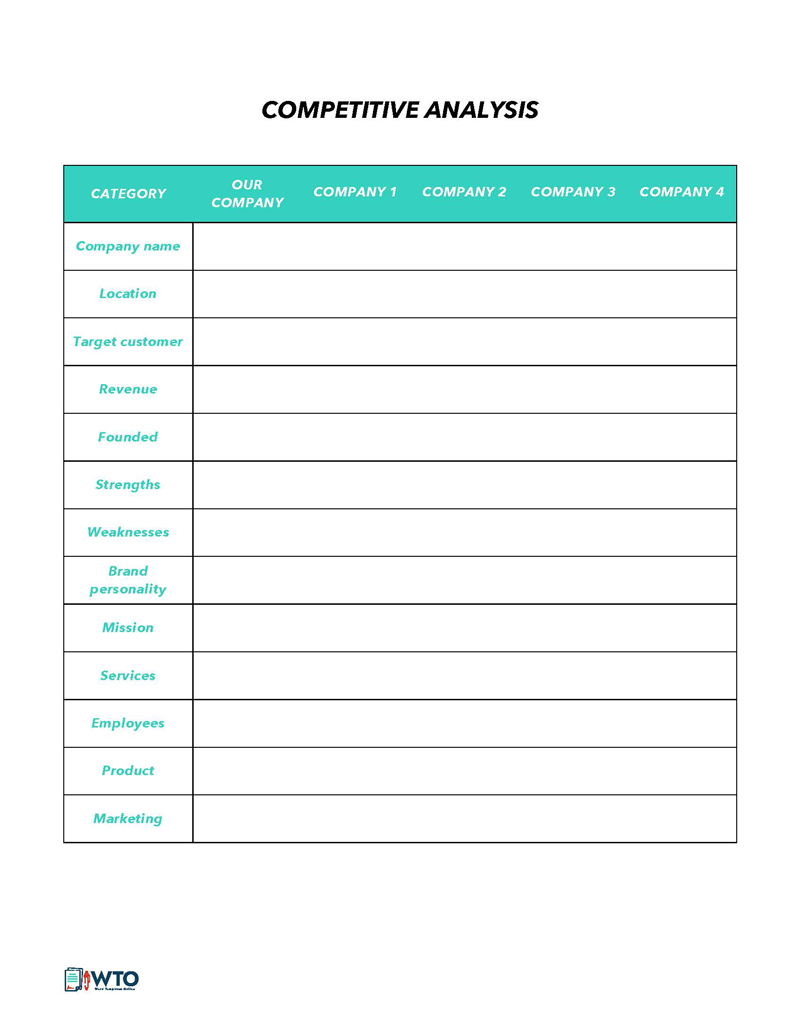
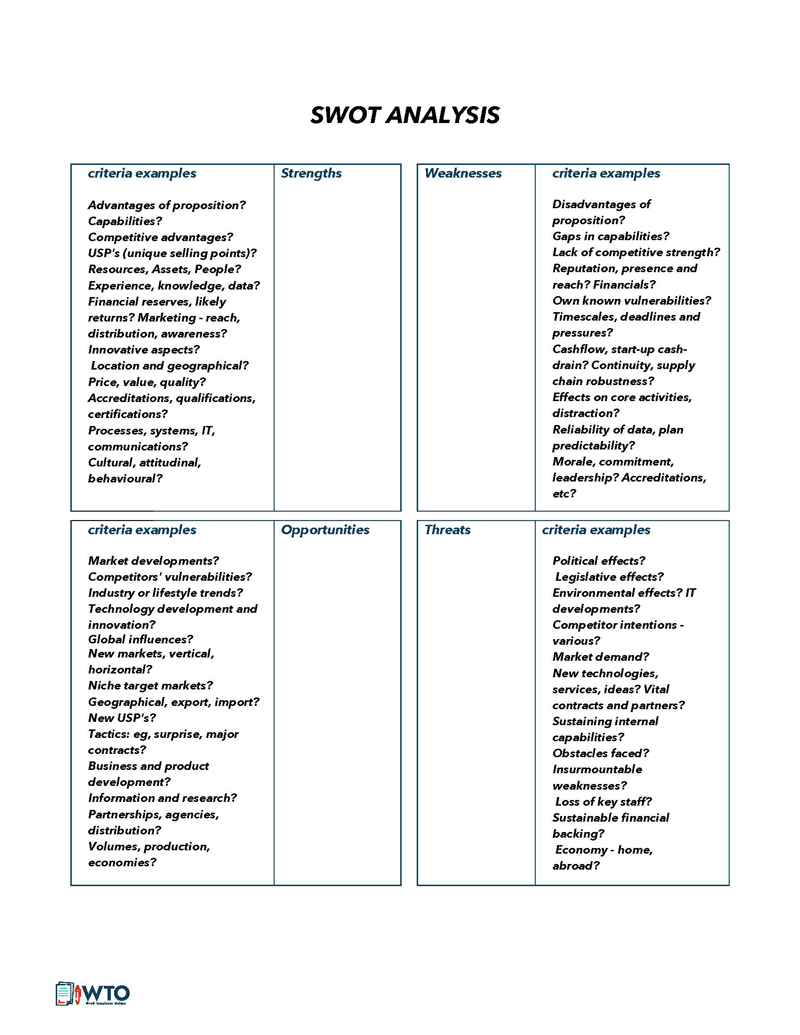
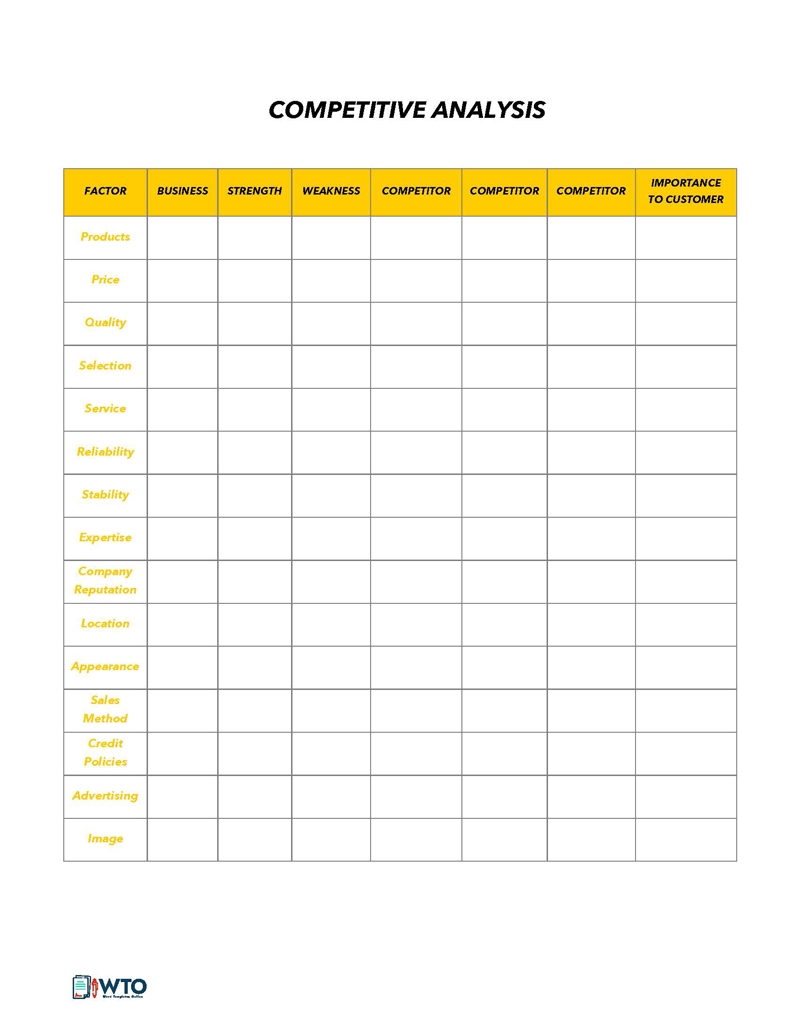
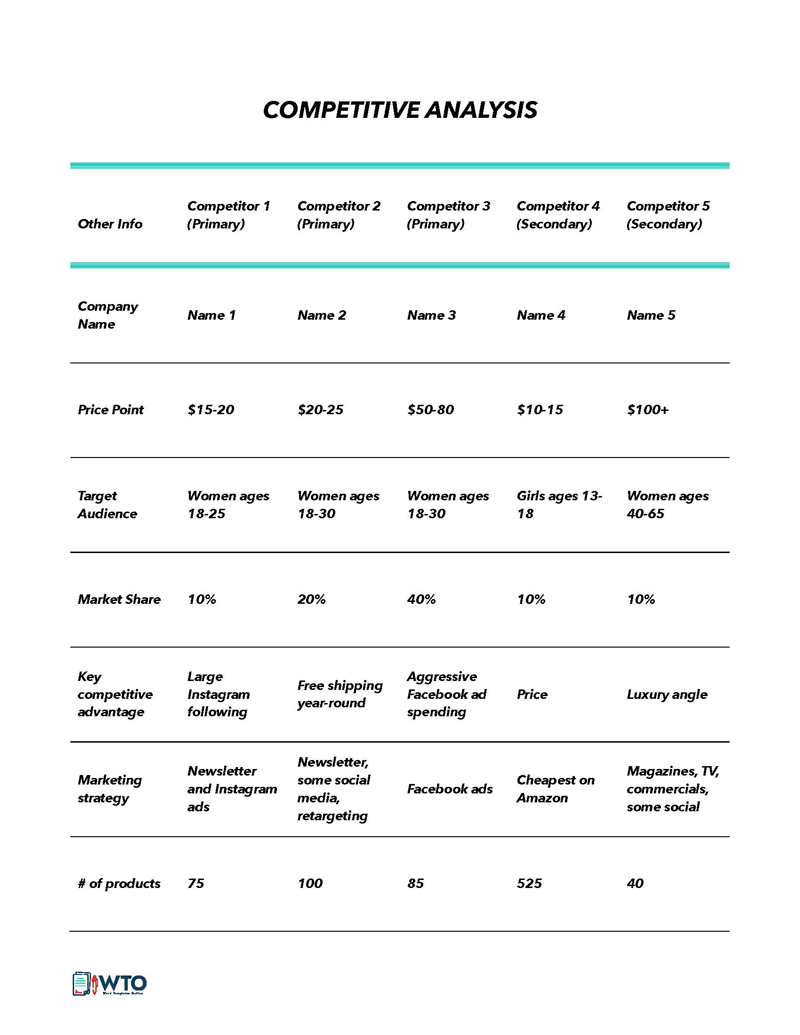
Excel format
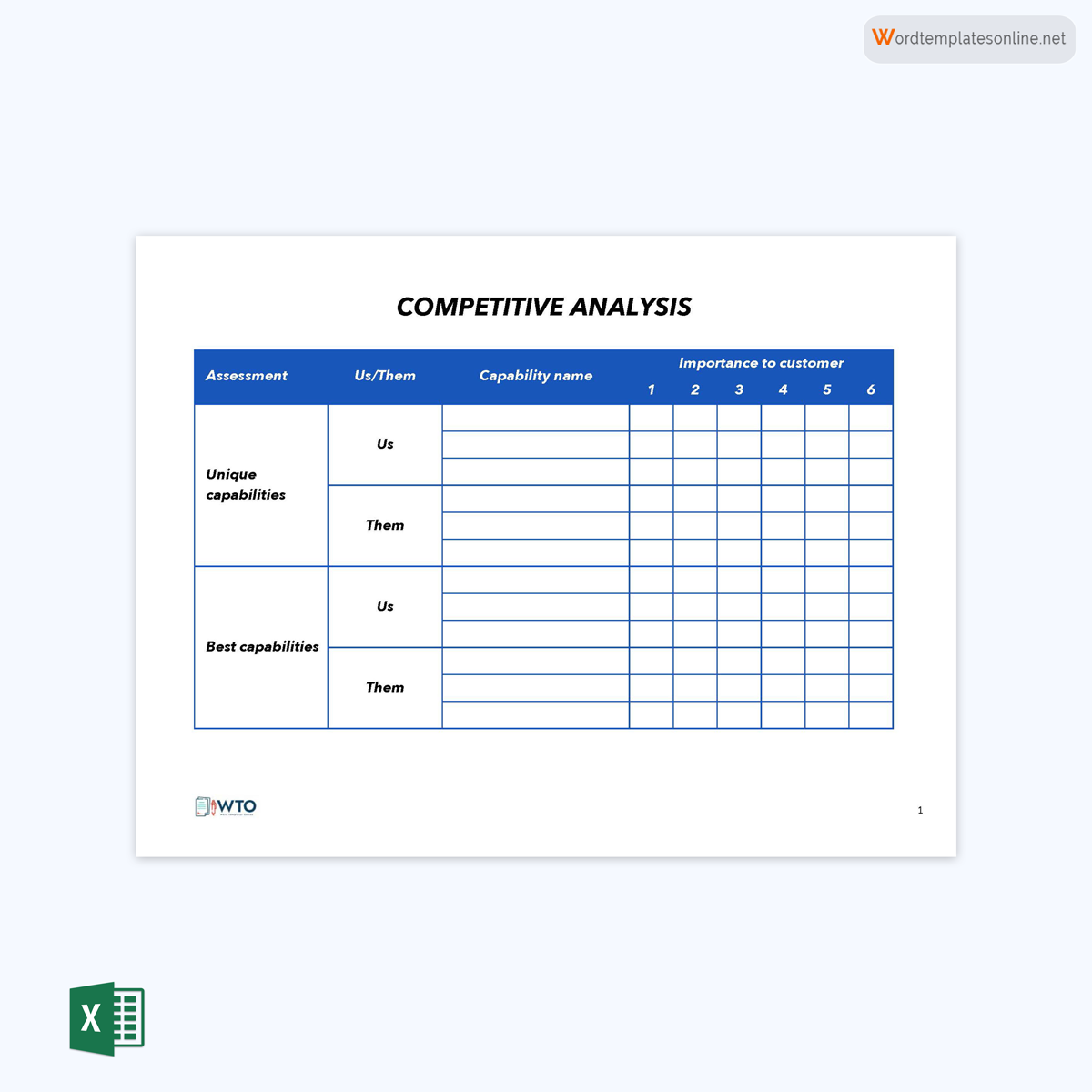
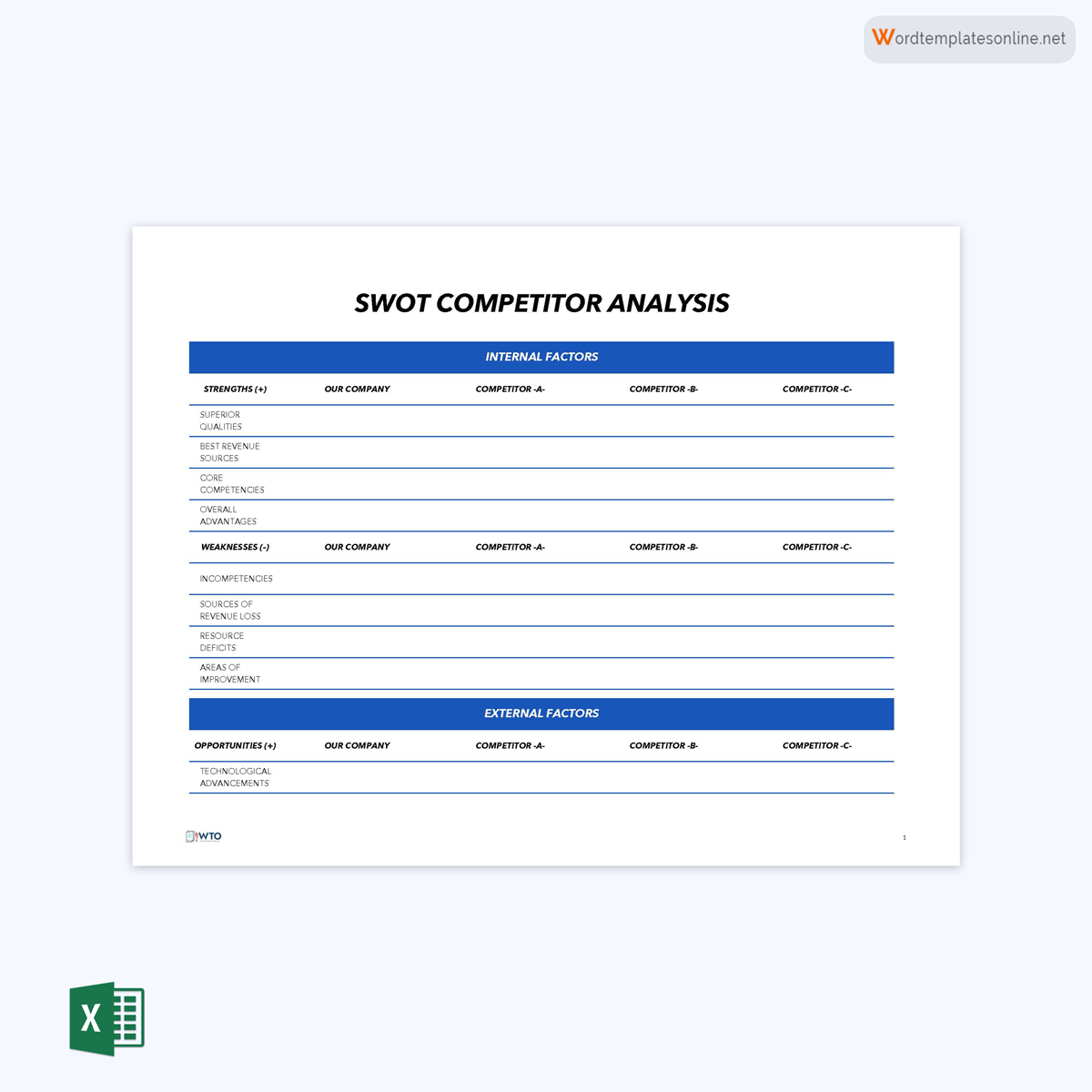
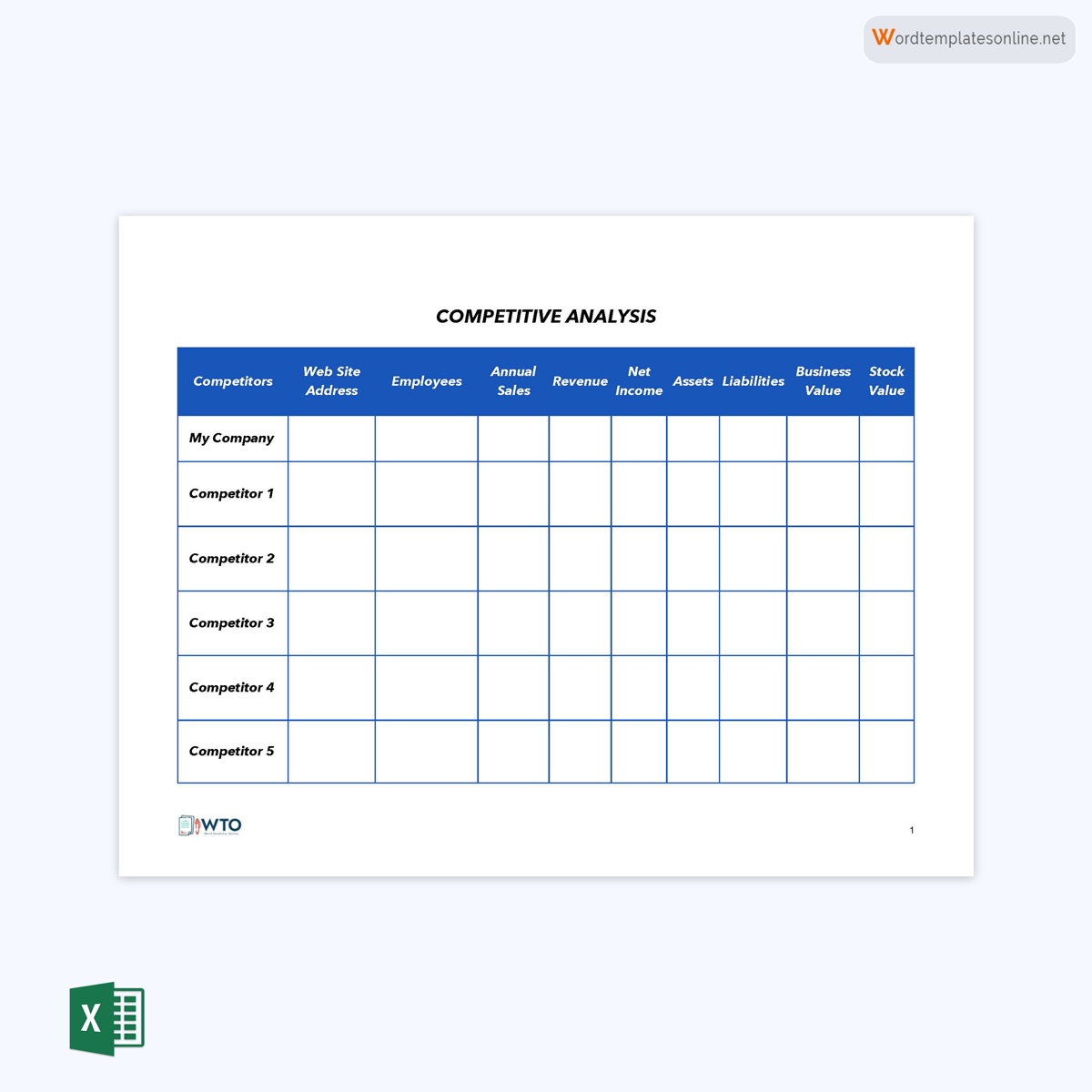
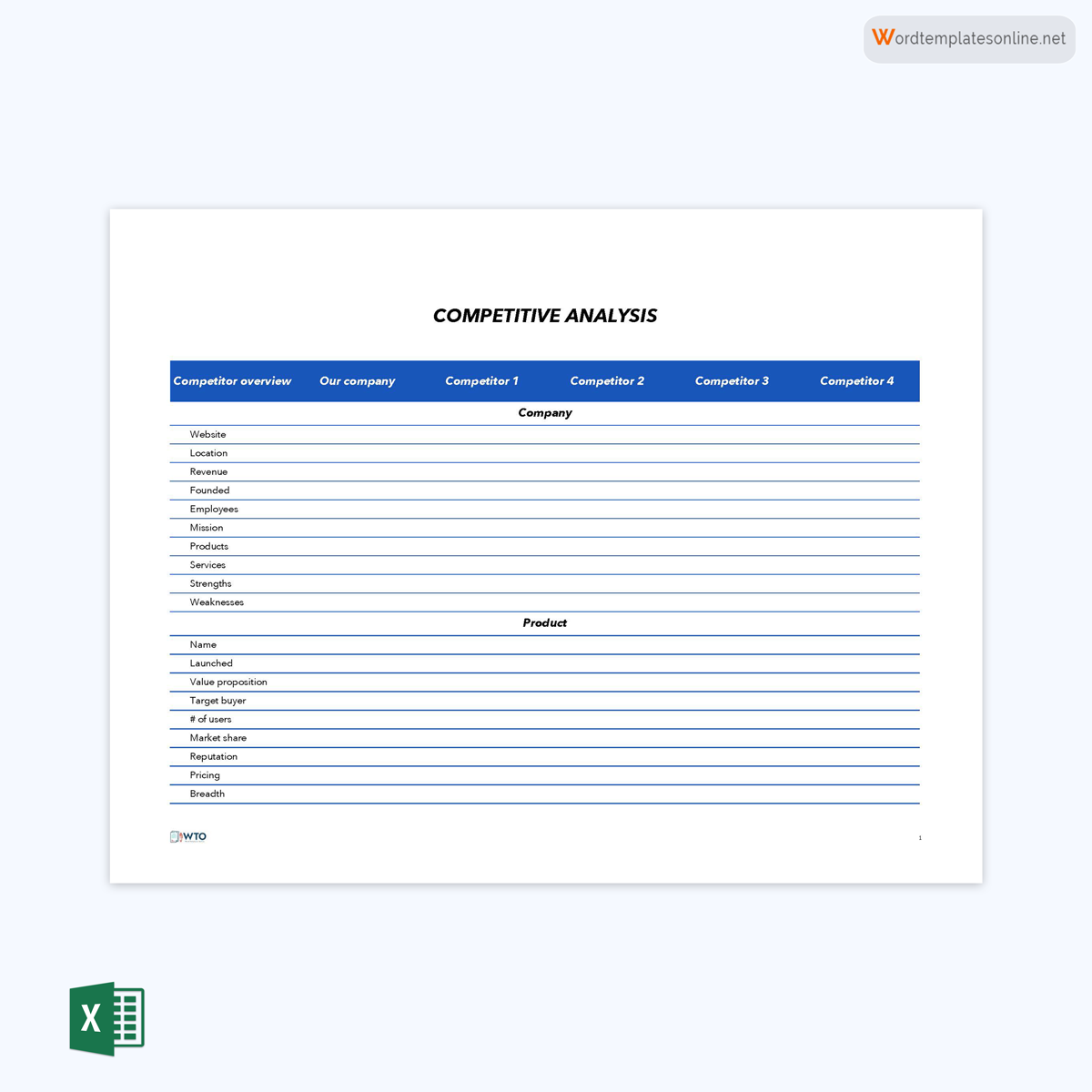
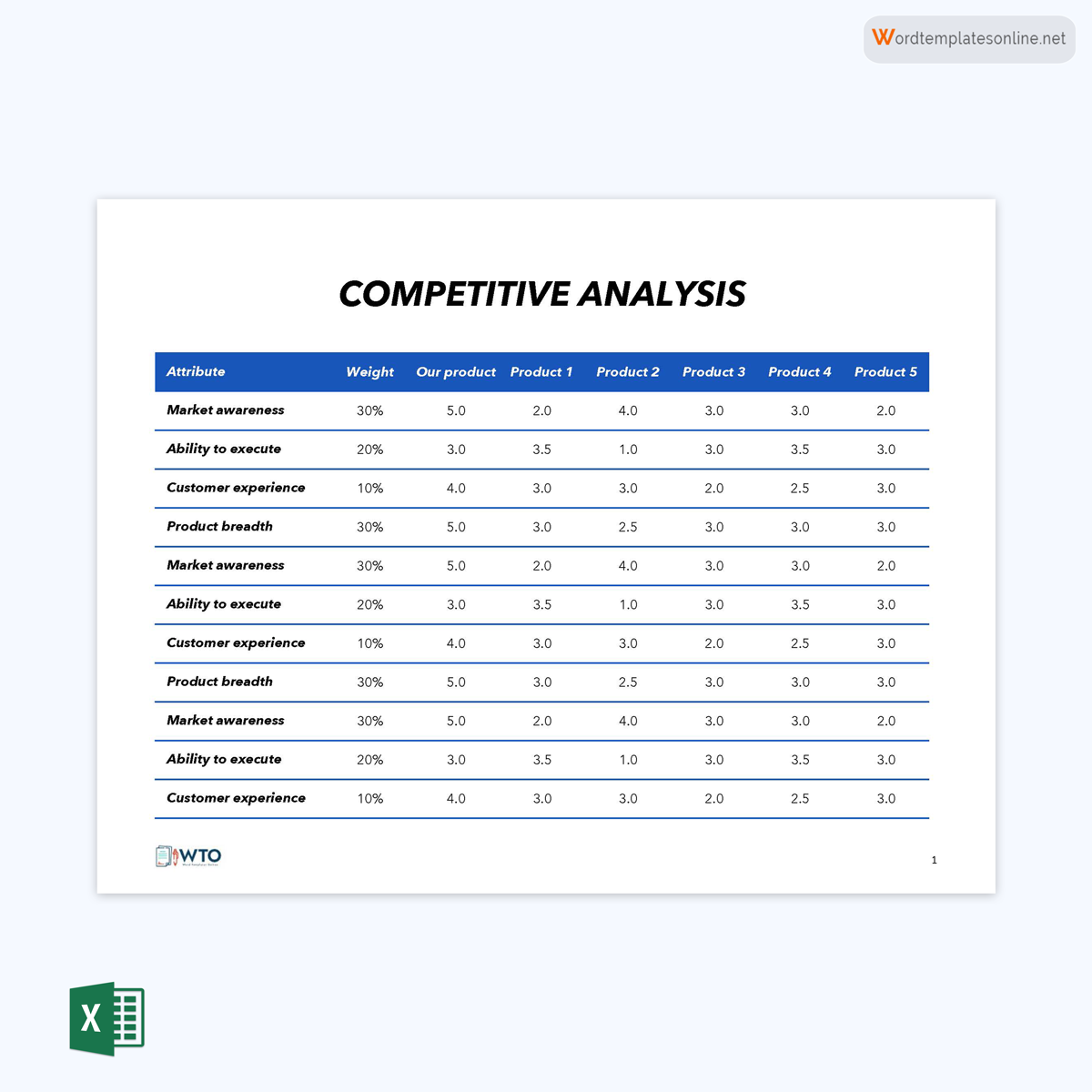
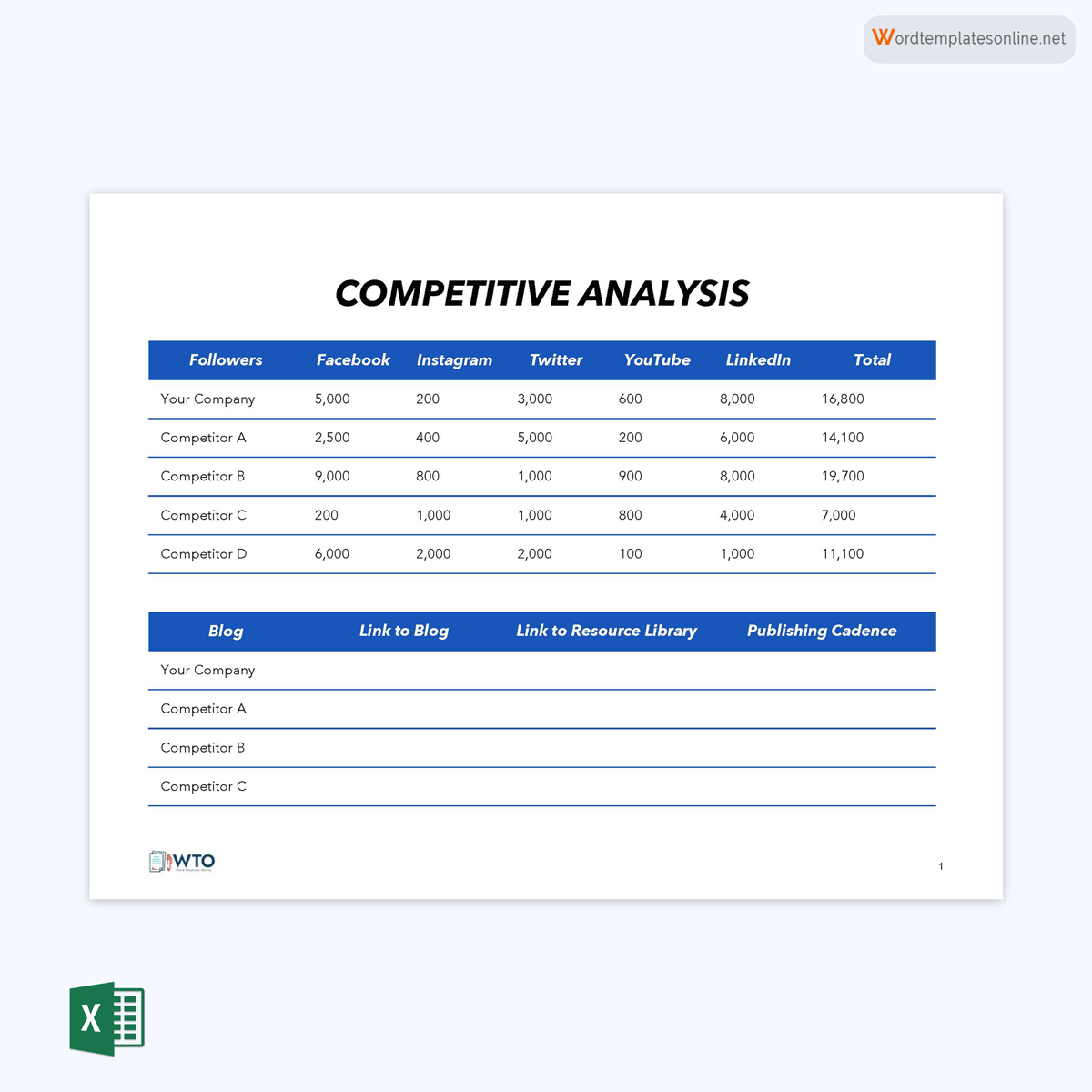
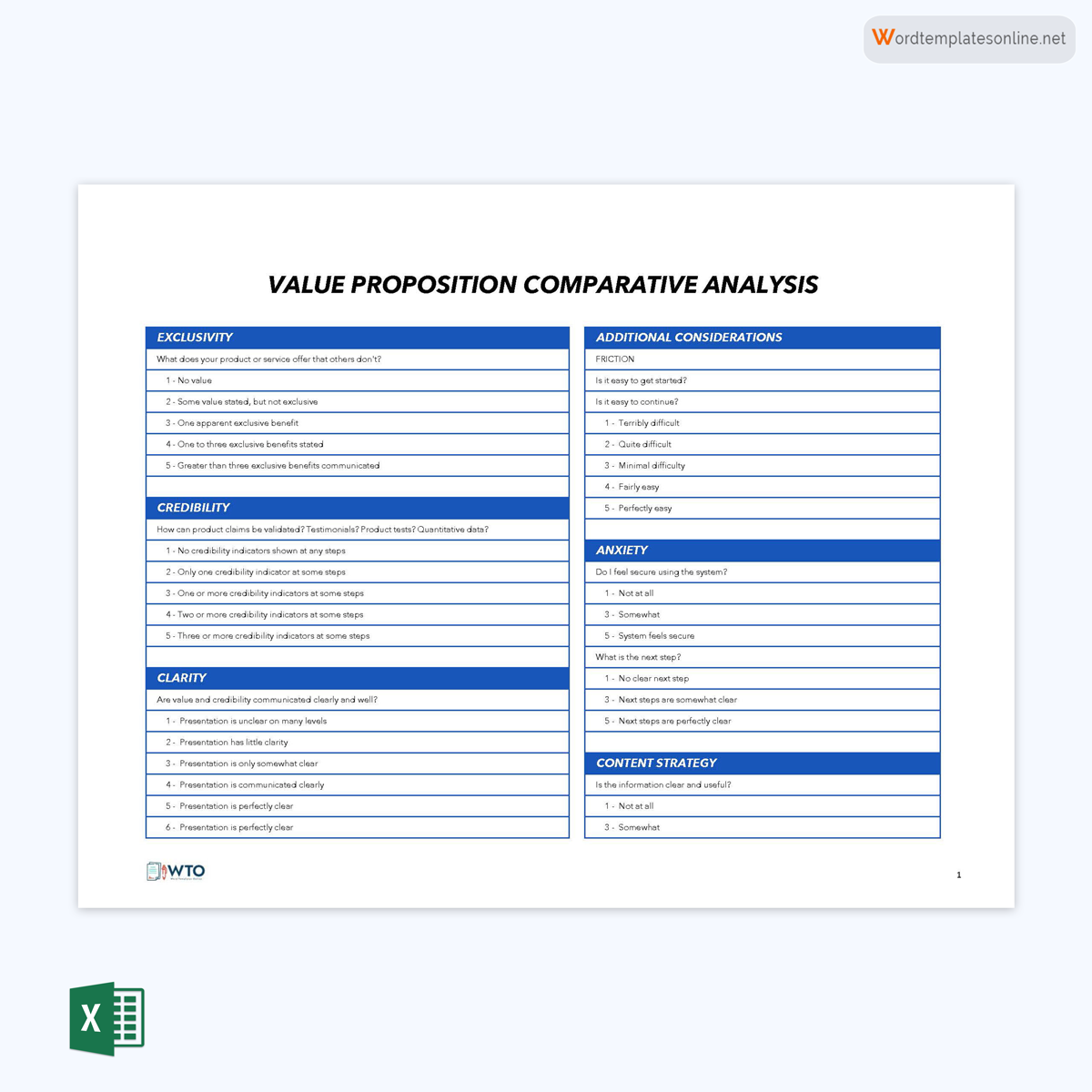
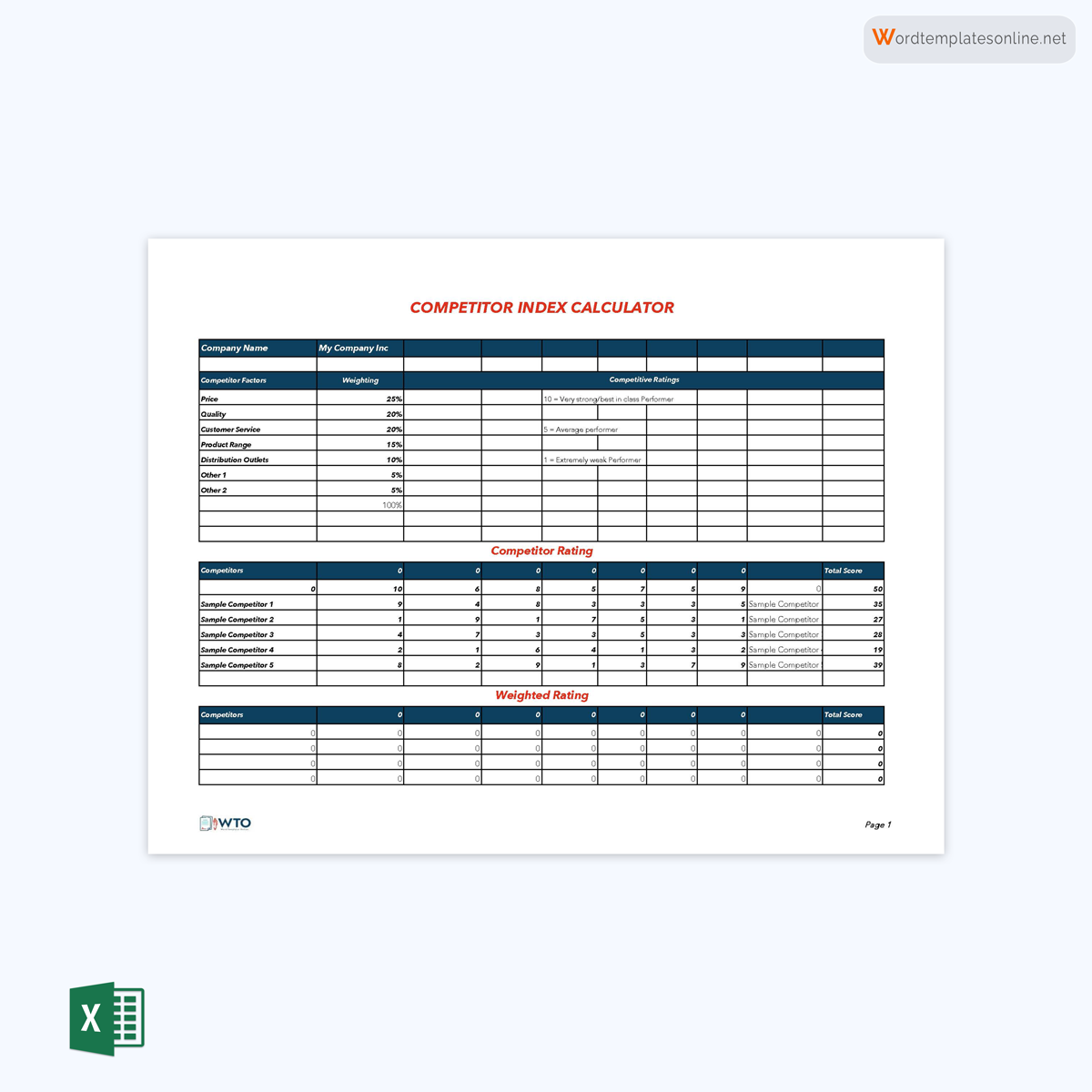
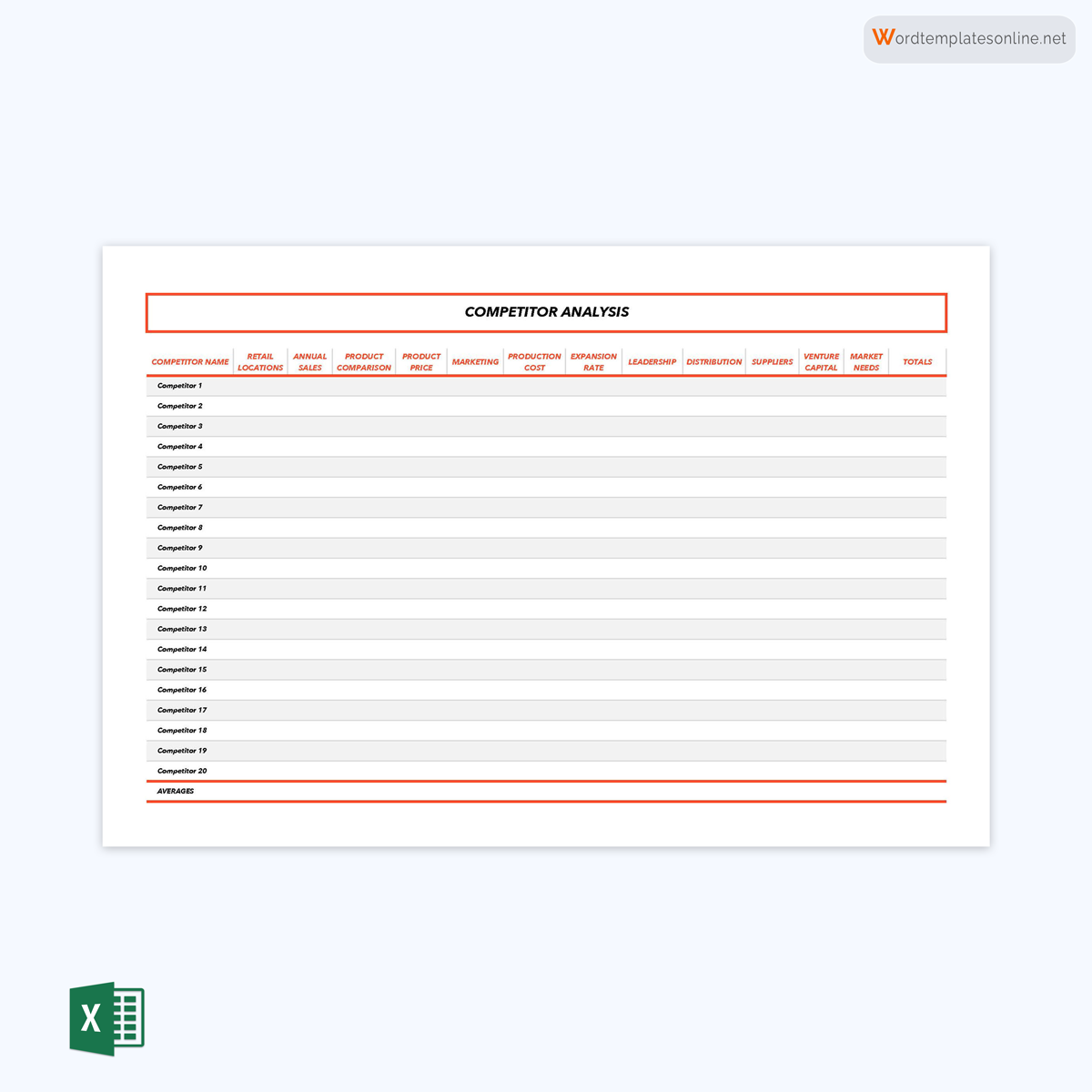
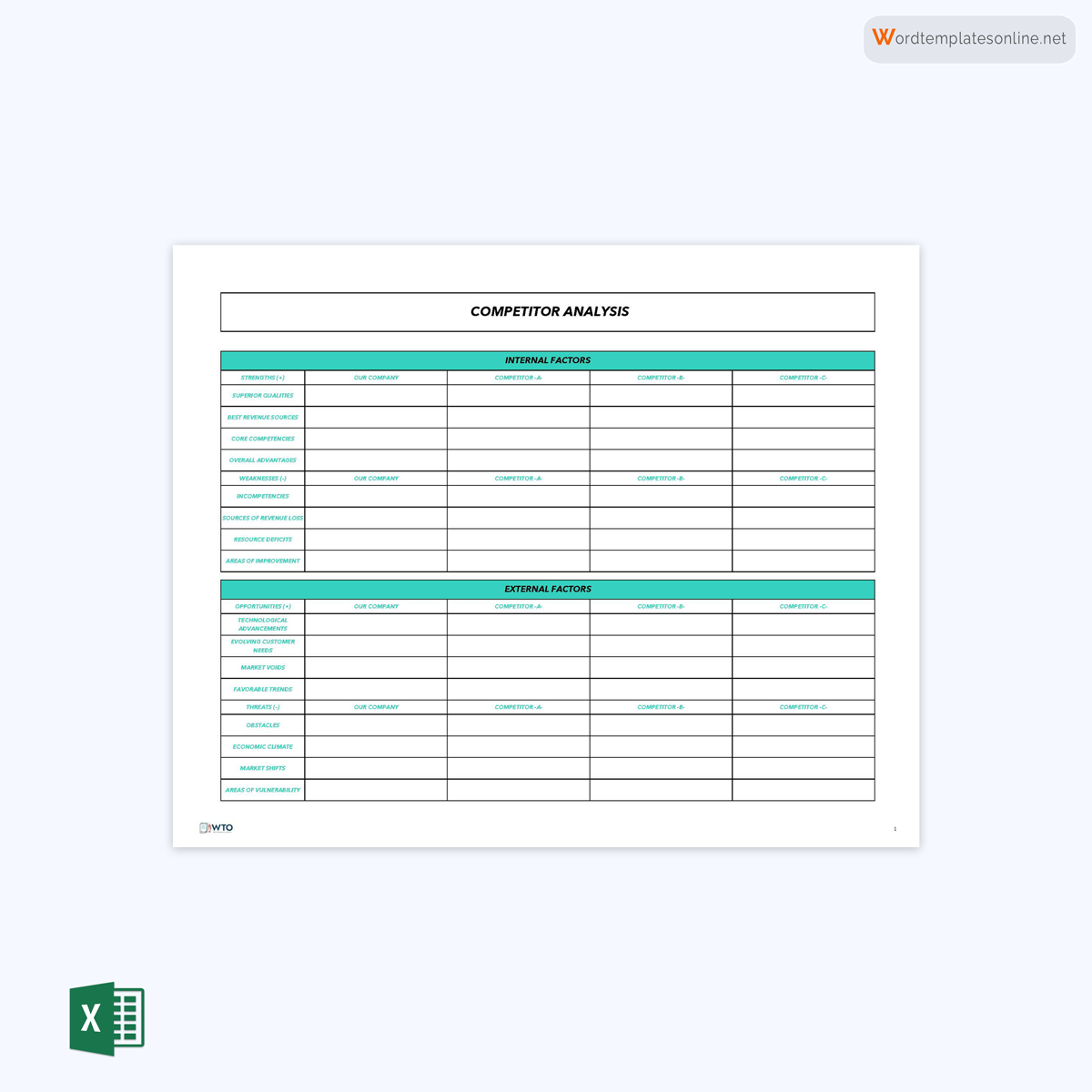
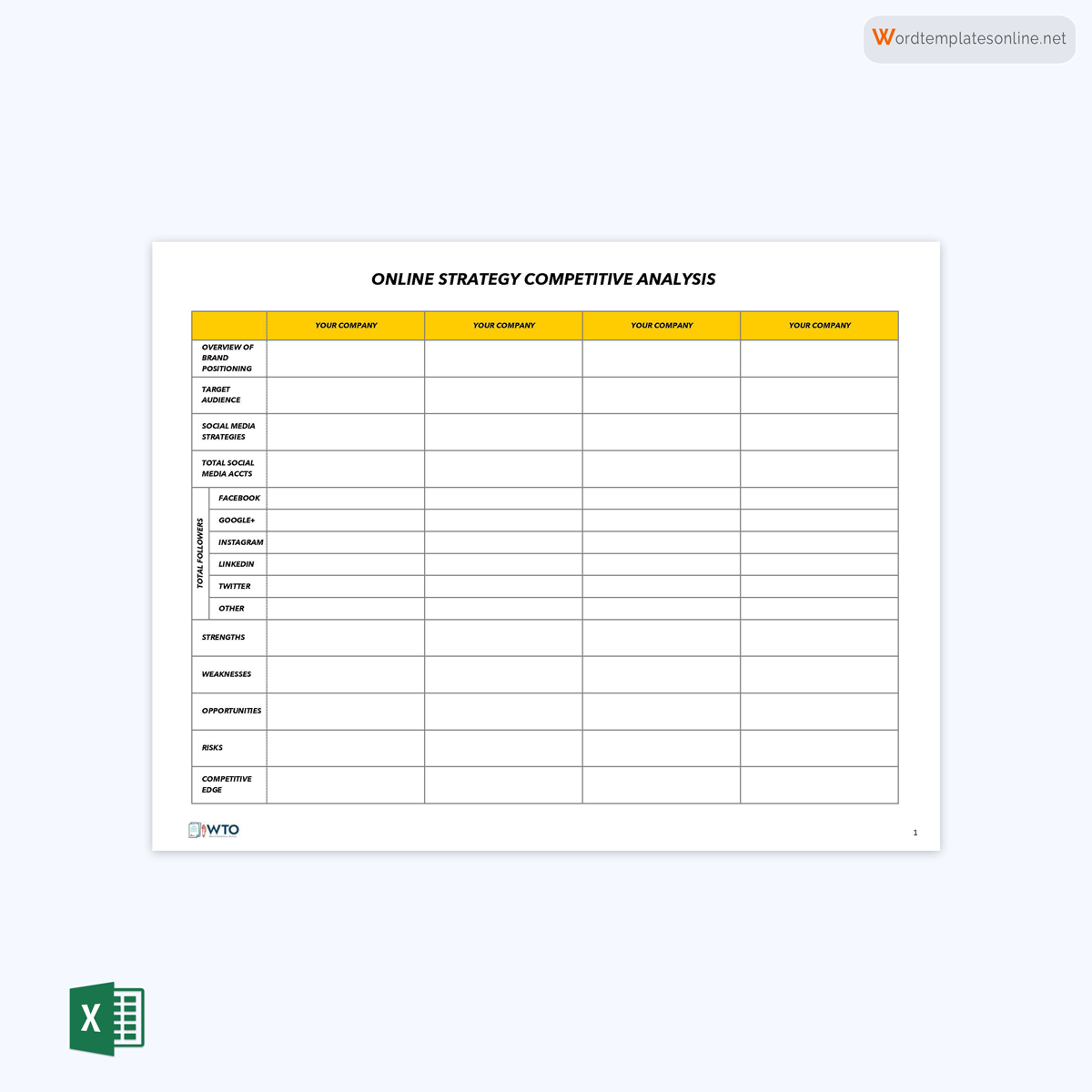
Pros and Cons
The competitive analysis offers numerous advantages for businesses. It allows you to identify the things that make your brand better than your competitors. However, it also shows you where your business is falling short in comparison with the leading brands in the market. Let’s compare the pros and cons so that you can make an informed decision on how to beat your competitors.
Pros
Here are some of the main pros of conducting regular analysis that should highlight the importance of keeping a close eye on your competition:
- Identifying your product’s unique value proposition: The analysis allows you to find the most effective way to create a unique value proposition to make your brand stand out. Your UVP sets the expectation bar for your customers. It is social proof of your brand’s trustworthiness and the primary reason your consumers keep coming back. Therefore, take your time to create a UVP for your customers that offers them something your competitors can’t match.
- Highlighting your competitor’s strengths: Knowing where your competitors excel can help you develop better marketing campaigns and business strategies for becoming a dominant force in your industry and beyond.
- Identifying your competitor’s weaknesses: Your competitor’s weaknesses are your strengths. Use them to discover new opportunities for disturbing the market with products and services that offer real value to consumers.
- Providing you with a benchmark: Implement newly identified unique value propositions and competitor strengths and weaknesses in your business strategies and measure your performance to ensure growth. Gather various metrics and analytics to keep enhancing your competitive approach by making the necessary improvements on the go.
- Helping you learn through customer reviews: Customer feedback can help you enhance your offerings by upgrading your products and services with innovative features that address your customers’ real-life needs.
Cons
While the analysis brings some undisputed benefits for business users, it also has a few downsides. Let’s briefly mention some of them:
- It is not a one-and-done exercise: It is an ongoing process. It requires constant updates of the insights you collect. Therefore, it requires time, effort, and resources.
- Confirmation bias: It is prone to jumping to conclusions. You should back up your assumptions with firm facts and figures to avoid making wrong decisions.
- Data without action is useless: The data you gather through your analysis should provide actionable insights into strategies that could help beat your competitors. Otherwise, it’s nothing but a load of information that serves no purpose.
- Working harder instead of smarter: Consider investing in competitive analytics tools to help you with data collection and data-driven business decisions. You can do it manually, but it might be quite a tedious endeavor. Analytics tools, on the other hand, give you leverage over your competitors. They make data collection, organization, management, and analysis easy due to the power of automation. Instead of wasting tremendous amounts of time on collecting data and conducting the analysis manually, you can harness the power of automation to drive highly accurate insights from your analyses and get ahead of the curve. More importantly, analytics tools save time, effort, and resources by eliminating human error and providing accurate, actionable insights for fueling your decision-making.
- Starting without a direction: The point of any analysis is to have a clear objective. This analysis without a clearly defined goal will make you work hard.
- Not accounting for market timing: Since there are so many factors to cover in your analysis, it’s easy to overlook vital aspects and analytics. Analyzing competitor data should give you actionable insights into the actions they have taken to ensure steady progress and business growth. In other words, you should focus on multiple aspects of your competitor’s analysis to understand their actions, techniques, and strategies for dominating the market. That should help you tap into the industry trends your competitors follow to cope with their tactics and outperform them.
Frequently Asked Questions
Take your time to analyze your business condition by assessing your marketing, sales, and business reports. Establish a baseline as a starting point for comparing your competition.
Essentially, the analysis helps you understand your competitors. For e-commerce businesses, it helps with:
● Improving marketing decision-making;
● Following the latest industry trends;
● Benchmarking against competition;
● Creating a unique value proposition;
● Adjusting pricing to industry standards;
● Discovering new ways of customer engagement and attracting new consumers;
● Improving digital marketing efforts.
No, SWOT is a framework for conducting competitor analysis by determining their strengths and weaknesses to discover new business opportunities and mitigate threats.




